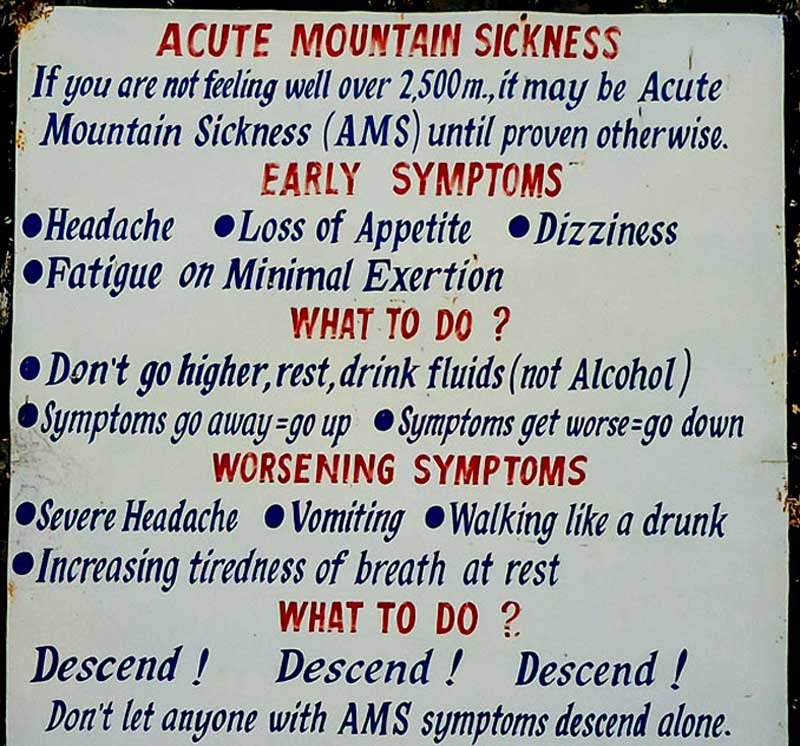Combating High Altitude Sickness

Travelling is always fun. A journey ill-prepared, however, may lead one to an unexpected circumstances. Trekking or hiking on high altitude regions, might be fun bit does carry some risks with them. High altitude sickness, accidents and some simple injuries at such altitudes might even lead to death.
Trekkers in high altitude areas must be prepared of the fact that, the higher you go higher the risk. Going slow, taking enough rest, being careful and spending adequate rest days for proper acclimatization can help in coping with high altitude sickness. Never hurry things while in the mountains.
Time for breakfast has significant role to play in this context. The more you have it, the safer you are. In other words, more flexible schedules help to escape, while the hurried ones usually lead into problems.
Altitude Sickness are commonly divided into three categories and these are quite common in the high mountains.
The first one is the Acute Mountain Sickness (AMS). It is an illness trekkers feel in the high altitudes while walking uphill. It could just be anything unspecific complication, difficulties in breathing and/or difficulties.
The second one is, High Altitude Pulmonary Edema (HAPE). It is considered to be comparatively dangerous as it is the result of formation of unnecessary fluids in the lungs.
And the third one is, High Altitude Cerebral Edema (HACE). This is the most dangerous of all. HACE is caused by formation of water in the brain. HACE makes all the brain unable to function properly. Physical complication or problem on trek means your body has difficulty adjusting with the environment. The higher you go, the less oxygen there is in the environment. It is estimated that at an altitude of about 4,500 meters has less than 50 percent of oxygen compared to the sea level.
The symptoms of altitude sickness begin to appear at an altitude of 3,000meters (10,000 ft). You can never be specific on the types of symptoms; there may be hundreds of them unclear and unspecified!
Altitude Sickness is very common in areas above 3,000m. Be prepared to accept whatever complication you have as symptom at least until the time you have proved it otherwise.
Altitude sickness is not as serious as it sounds. It is estimated that about 30 percent of the trekkers suffers from altitude sickness, but only a few cases end up as a real tragedy. If you make a note some precautionary measures and be prepared to act accordingly, it is almost guaranteed that you will not run into problems. Always be able to identify the symptom as its earliest stage. If you think you have developed the symptoms, do not go further. If the symptoms disappear after rest, continue on your journey and if it still remains unchanged, consider going downfall. If the symptoms begins getting worse while you are resting, immediately go downhill. For example, if your symptoms started as a simple headache but you begin to throw out in an hour, it is important that you act immediately even if it is in the middle of the night or you need to be carried on the back of the porter.
Well, just keep your fingers crossed and hope you don’t run into a situation that requires Emergency Rescue Evacuation. Prevention is much better than cure, so be aware of the conditions in which you are in.
Common Symptoms
Headache: Every time you have a headache does not necessarily mean you have altitude sickness. In such case, take a break. If your headache is anything other than a symptom of altitude sickness, it should go off after some rest. If you still have it after a complete rest, it is definitely a symptom. Do not go higher!
Tiredness: It might not be unusual for one to feel tired after a day long walk especially when you walk uphill or go faster than normal. But how long will it take recover, is the question. A rest of few hours should help to regain the energy and enthusiasm to trek higher. We should take it more seriously if someone often complains of not feeling well, is always tired, walks with a lot of difficulties, arrives at his campsite very late, is always the last one of the row on the trail, spends more time sleeping or is often seen lying in the ground.
Pulse: Check your pulse. 60 pulse a minute in an average is normal condition. It is normal for pulse rate to increase when you walk uphill or faster, Do not panic in such cases, a short break should bring it down to normal. Only if pulse if around 100, it should be considered as symptoms.
Coughing: It is not unusual for one to cough at such dry and cold temperature. Take a break and check the improvement after rest. If the problem persists, it might be a symptom. Stop ascending further.
Intense Breathing: It is normal to get intense breathing while walking uphill or faster. Take a break. If your breathing is not normal after some rest, it might be a symptom. Stop ascending further.
Loss of Appetite: The more you eat or drink the better it is. Since your body requires a lot of energy to function properly, you should drink enough fluids and adequate foods. Loss of your appetite and throwing at the same time can be quite dangerous.
Disorientation: This is probably the most dangerous symptoms of altitude sickness. You should be more careful if you become disoriented or walk as a drunk. Your brain may have been adversely affected .It is normal for one to lose balance after a long or hard walk. Take a short break and you are ready to go. If you still feel dizzy or disoriented than it is the time when you stop going any further.
Precautions
Diamox 250mg: This medicine will help you to stay away from altitude sickness. Consult with your doctor for recommended dose.
Go Slow: Do not go too fast when you are at an altitude of 3,000m (10,000 ft) or above and srart walking uphill. Take it easy. Go slow.
Limited Gain in Altitude: Make sure your total gain in altitude in between the place you wake up and the one you sleep at the end of the day is not more than 300m or 1000 ft..
Acclimatize: Spend two nights resting after a gain of every 1000m (approx 3000 ft) each.
Drink a lot: Considering the dry climate at high altitude, drinking four liters of liquid regularly each days helps to reduce the risk.
No Alcohol: Since they only help to hide the symptoms., avoid taking alcohol and sleeping pills.
Pack Light: Carry only a light backpack. Those carrying heavy backpack are seen running into trouble often. Minimize the weight of your pack. Try to bring it down to 8kg.
Use your conscience: Do not listen to others. Altitude sickness is unpredictable. Your age or the shape and the size of the body has absolutely no role to play. One of the two or more trekkers in a group may develop the symptoms at any time but others may not. Do not let others pressure you. If you think you have the symptoms, do not go higher.
Source: Image Nepal
Related Post
Recent Post
- Visit Nepal 2024
- Shrawan Sankranti
- Must Try Off the Beaten Trekking Routes of Nepal
- Political Stability is a must for Nature conservation:
- Combating High Altitude Sickness
- Climate Change and the Himalayas
- What is Kathmandu?
- 13 Necessary Equipment for Peak Climbing in Nepal
- About Prayers Flag
- How did a Pothead Shiva come to be a Hindu God?







